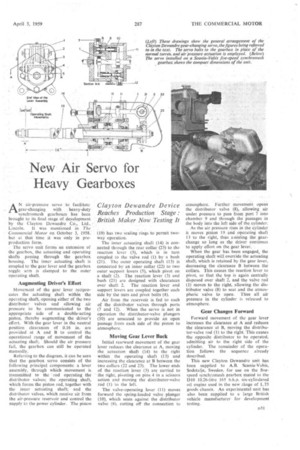New Air Servo for
Page 79

If you've noticed an error in this article please click here to report it so we can fix it.
Heavy Gearboxes
Clayton Dewandre Device Reaches Production Stage : British Maker Now Testing It
AN . air-pressure servo to facilitate
gear-changing with . heavy-duty synchromesh gearboxes has been brought to its final stage of development by • the Clayton Dewandre Co., Ltd., Lincoln.. It was mentioned in The Commercial Motor on October 3, 1958, but at that time it was only in pre production form. , The servo unit forms an extension of the gearbox, the actuating and operating shafts passing through the gearbox housing. The inner actuating shaft is coupled to the gear lever and the gearbox toggle arm is clamped to the outer operating shaft.
Augmenting Driver's Effort
Movement of the gear lever reciprocates the actuating shaft within the operating shaft, opening either of the two distributor valves and allowing air pressure to be communicated to the appropriate side of a double-acting piston, thereby augmenting the driver's effort. With the gear lever in the neutral position clearances of 0.16 in. are provided at A and B to control the operational range of movement of the actuating shaft. Should the air pressure fail, the gearbox can still be operated manually.
Referring to the diagram, it can be seen that the gearbox servo consists of the following principal components; a lever assembly, through which movement is transmitted to the :rod operating the distributor valves; the operating shaft, which forms the piston rod, together with the inner actuating shaft; and the distributor valves, which receive air from the air-pressure reservoir and control the supply to the power cylinder. The piston (19) has two sealing rings 'to' permit twoway operation.
The inner actuating shaft (14) is connected through the rear collar (23) to the reaction lever (3), which is in turn coupled to the valve rod (1) by a bush (21). The outer operating shaft (13) is connected by an inner collar (22) to two outer support levers (5), which pivot on a shaft (2). The reaction lever (3) and bush (21) are designed with clearances over shaft 2. The reaction lever and support levers arc coupled together each side by the nuts and pivot bolts (4). .
Air from the reservoir is fed to each of the distributor valves through ports (7 and 12). When the servo is not in operation the distributor-valve plungers (10) are unseated to provide an open passage from each side of the piston to atmosphere.
Moving Gear Lever Back Initial rearward movement of the gear lever reduces the clearance at A, moving the actuation shaft (14) to the right within the operating shaft (13) and increasing the clearance at B between the two collars (22 and 23). The lower ends of the reaction lever .(3) are carried to the right, pivoting on pins 4 in a scissors action and moving the distributor-valve rod (1) to the left.
The valve-operating lever (11) moves forward the spring-loaded valve plunger (10), which seats against the distributor valve (8), cutting off the connection to atmosphere. Further movement opens the distributor valve (8), allowing air under pressure to pass from port 7 into chamber 9 and through the passages in the body into the left side of the cylinder.
As the air pressure rises in the cylinder it moves piston 19 and operating shaft 13 to the right, thus •a ;sisting the gearchange so long as the driver continues to apply effort on the gear lever..
When the gear has been engaged, the operating shaft will override the actuating shaft, which is retained by the gear lever, decreasing the clearance B between the collars. This causes the reaction lever to pivot, so that the top is again centrally disposed over shaft 2, and the valve rod (1) moves to the right, allowing the distributor valve (8) to seat and the atmospheric valve to open. Thus all air pressure in the cylinder is released to atmosphere.
Gear Changes Forward
Forward movement of the gear lever increases the clearance at A and reduces the clearance at B. moving the distributor-valve rod (1) to the right This causes the opposite distributor to be operated, admitting air to the right side of the cylinder. The remainder of the operation follows the sequence already described.
This new Clayton Dewandre unit has been supplied to A.B. Scania-Vabis, Sodetalie, Sweden, for use on the fivespeed synchromesh gearbox mated to the DIO 10.26-litre 165 b.h.n. six-cylindered oil engine used in the new range of L.75 goods chassis. An experimental unit has also been supplied to a large British vehicle manufacturer for development testing,
































































































































